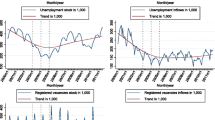Abstract
This paper uses matched employee–employer LIAB data to provide panel estimates of the structure of labor demand in western Germany, 1993–2002, distinguishing between highly skilled, skilled, and unskilled labor and between the manufacturing and service sectors. Reflecting current preoccupations, our demand analysis seeks also to accommodate the impact of technology and trade in addition to wages. The bottom-line interests are to provide elasticities of the demand for unskilled (and other) labor that should assist in short-run policy design and to identify the extent of skill biases or otherwise in trade and technology.
Similar content being viewed by others
Notes
We shall subsequently impute wages that are reported to be at the ceiling.
The Panel survey is based on the employment statistics via the establishment identifier. As a result, the panel only includes establishments with at least one employee covered by social security.
In a subset of estimates using this variable (see Table 8, below), since the Establishment Panel measures organizational change over a 2-year interval we chose to use data from 1995 to impute values for the years 1993 and 1994 (thus dropping 1995), data from 1998 to impute values for 1996 and 1997, data from 2000 to impute values for 1998 and 1999, and finally data from 2001 to impute a value for 2000 (dropping 2001). In other words, for specifications using the organizational change argument we lose three years of data, including 2002 for which there was no organizational change question in the Establishment Panel.
The questions concern the legal form of the firm and the definition of business volume. We excluded two such legal forms (Körperschaft des öffentlichen Rechts and Sonstige Rechtsform {z.B. Verein, Genossenschaft}), in addition to those units that defined their business volume in terms of budget rather than sales.
Following Bauer and Bender (2004), we also experimented with an occupational-based representation of the workforce, wherein workers were classified into just three categories—unskilled, skilled, and highly skilled—notwithstanding their white- or blue-collar status. The results of this exercise are briefly reported on in the Findings section.
An alternative representation of the technology is given by the Translog cost function (Christensen et al. 1973), which also can be viewed as a local second-order approximation of an arbitrary cost function. In this case, the factor shares rather than the conditional factor demands are linear in the relevant parameters of the cost function. The resulting system of cost share equations can also be estimated by the SUR technique described below.
They can also be used to obtain more direct measures of skill-biased technological change than a trend term added to the regression.
By definition, any cost function is concave in factor prices. However, in the case of the Generalized Leontief function, imposing (global) concavity destroys flexibility (cross-price elasticities, in particular, will become necessarily positive). Local concavity can, alternatively, be imposed (Ryan and Wales 2000), and in this case it has been shown that factor price elasticities are roughly equivalent to the case where no concavity restriction is imposed. We used this result, and as consequence did not force any type of concavity to our system of demand functions.
Our imputation procedure, based on the predicted wage plus an error term, also guarantees that the imputed wage is never below the ceiling. Results are available from the authors on request. We also experimented with alternative imputation methods. For example, the results of imputations from estimating one wage equation per year across all skill categories for the manufacturing and service sectors are similar to those reported in Tables 6 and 7, with the main differences being confined to the highly skilled. Full results are available from the authors upon request.
We should note that there are disparities between the sum of employees obtained from the employment statistics and the total given in the establishment panel. Where these amounted to 20% or more we chose to exclude the plant from the sample, treating the establishment identifier as flawed.
Specifically, panel survey respondents are asked to estimate the percentage share of total sales represented by materials cost, so that multiplying sales volume by 1 minus this share yields value added.
Respondents in the Establishment Panel survey are asked to rate the technical condition of the plant’s equipment compared with that of other firms in the industry/sector along a Likert scale where 1 indicates ‘state-of-the-art’ (auf dem neuesten stand) equipment and 5 indicates ‘obsolete’ equipment (völlig veraltet). In forming a modern technology dummy, we grouped categories 1 and 2.
We also looked at separate samples to test for parameter shifts along the dimensions of plant size and collective bargaining coverage. (Due to sample size, we restricted our investigation to manufacturing alone.) For plant size we considered three size groups: less than 100 employees, between 100 and 999 employees, and 1,000 or more employees. In all three subsamples, the sign of the own-wage elasticity changed once, while the output elasticity changed twice (in a total of 24 cases) and in only one case was the new coefficient statistically significant. There were no obvious changes in the pattern of the remaining elasticities. As far as the magnitude of the coefficient estimates is concerned, skilled and highly skilled employees in bigger plants tended to have larger own-wage and output elasticities than in the benchmark analysis reported in the text. Finally, analysis by collective bargaining status was more difficult to pursue given the limited number of uncovered plants. Nevertheless, we can for example report that for this (very small) the own-wage elasticities always had the expected sign.
References
Addison JT, Schank T, Schnabel C, Wagner J (2006) Works councils in the production process. Schmollers Jahrb 126:251–283 (October)
Bauer TK, Bender S (2004) Technological change, organizational change, and job turnover. Labour Econ 11:265–291 (June)
Bellmann L, Pahnke A (2006) Auswirkungen organisatorischen Wandels auf die betriebliche Arbeitsnachfrage. Zeitschrift für Arbeitsmarkt- und Berufsforschung 39:201–233
Bellmann L, Schank T (2000) Innovations, wages and demand for heterogeneous labor: new evidence from a matched employer–employee data-set. IZA Discussion Paper No. 112. Institute for the Study of Labor, Bonn
Bellmann L, Bender S, Schank T (1999) Flexibilität der Qualifikationsstruktur aus betrieblicher Sicht: Substitutionalität oder Komplementarität. Jahrb Natl ökon Stat 219:109–126 (July)
Bellmann L, Caliendo M, Hujer R, Radic D (2002) Beschäftigungswirkungen technisch-organisatorischen Wandels: eine mikroökonometrische Analyse mit dem Linked IAB-Panel. Mitt Arbeitsmarkt- Berufsforsch 35/4:506–522
Bender S, Haas A, Klose C (2000) The IAB Employment Subsample, 1975–1995. Schmollers Jahrb 120:649–662
Bond SR, van Reenen J (2007) Microeconometric models of investment and employment. In: Heckman JJ, Leamer EE (eds) Handbook of econometrics, vol. 6. Elsevier, New York
Cahuc P, Zylberberg A (2004) Labor Economics. MIT, Cambridge, MA
Christensen LR, Jorgenson DW, Lau LJ (1973) Transcendental logarithmic production frontiers. Rev Econ Stat 55:28–45 (February)
Diewert WE (1971) An application of the Shephard duality theorem: a Generalized Leontief production function. J Polit Econ 79:481–507 (May–June)
Falk M (2002) Endogenous organizational change and the expected demand for skilled workers. Appl Econ Lett 9:419–423 (June)
Falk M, Koebel B (2001) A dynamic heterogeneous labour demand model for German manufacturing. Appl Econ 33:339–348 (February)
Falk M, Koebel B (2004) The impact of office machinery and computer capital on the demand for heterogeneous labour. Labour Econ 11:99–117 (February)
Falk M, Seim K (1999) Workers’ skill level and information technology: evidence from German service firms. In: Bellmann L, Steiner V (eds) Panelanalysen zu Lohnstruktur, Qualifikation und Beschäftigungsdynamik. Bundesanstalt für Arbeit, Beiträge zur Arbeitsmarkt- und Berufsforschung, Nürnberg, pp 79–116
Falk M, Seim K (2001a) The impact of information technology on high-skilled labour in services: evidence from firm level panel data. Econ Innov New Technol 10:289–323
Falk M, Seim K (2001b) Workers’ skill level and information technology: a censored regression model. Int J Manpow 22:98–120
Fitzenberger B (1999a) International trade and the skill structure of wages and employment in West Germany. Jahrb Natl ökon Stat 219:67–89 (July)
Fitzenberger B (1999b) Wages and employment across skill groups: an analysis for West Germany. Physica Verlag, Heidelberg
Fitzenberger B, Franz W (1997) Flexibilität der qualifikatorischen Lohnstruktur und Lastverteilung der Arbeitslosigkeit: Eine ökonometrische Analyse für Westdeutschland. ZEW Discussion Paper No. 97–32. Mannheim: Centre for European Economic Research
FitzRoy F, Funke M (1998) Skills, wages, and employment in East and West Germany. Reg Stud 32:459–467 (July)
Hujer R, Caliendo M, Radic D (2002) Skill biased technological and organizational change: estimating a mixed simultaneous equation model using the IAB establishment panel. IZA Discussion Paper No. 566. Bonn: Institute for the Study of Labor
Kaiser U (2001) The impact of new technologies on the demand for heterogenous labor: empirical evidence from the German business-related services sector. Rev Ind Organ 19:109–120 (August)
Kölling A (2000) The IAB establishment panel. Schmollers Jahrb 120:291–300
Kölling A, Schank T (2003) Skill-biased technological change, international trade and the wage structure. In: Bellmann L, Hujer R (eds) Betriebliche innovationen im Spiegel von Betriebsbefragungen. Institut für Arbeitsmarkt- und Berufsforschung der Bundesanstalt für Arbeit, Nürnberg, pp 113–134
Lindbeck A, Snower DJ (2000) Multitask learning and the reorganization of work: from Tayloristic to holistic organization. J Labor Econ 18:353–376 (July)
Ryan DL, Wales TJ (2000) Imposing local concavity in the translog and Generalized Leontief cost functions. Econ Lett 67:253–260 (June)
Wolf E, Zwick T (2002) Reassessing the impact of high performance workplaces. ZEW Discussion Paper No. 02–07: Centre for European Economic Research, Mannheim
Author information
Authors and Affiliations
Corresponding author
Appendix
Appendix
Rights and permissions
About this article
Cite this article
Addison, J.T., Bellmann, L., Schank, T. et al. The Demand for Labor: An Analysis Using Matched Employer–Employee Data from the German LIAB. Will the High Unskilled Worker Own-Wage Elasticity Please Stand Up?. J Labor Res 29, 114–137 (2008). https://doi.org/10.1007/s12122-007-9026-x
Published:
Issue Date:
DOI: https://doi.org/10.1007/s12122-007-9026-x




